MAE101 Economic Principles Assignment: Sugar Tax Impact Analysis, 2020
VerifiedAdded on 2023/01/11
|9
|1575
|75
Homework Assignment
AI Summary
This assignment analyzes the economic principles of sugar taxes, focusing on case studies from Mexico and Australia within the context of MAE101 Economic Principles. It begins by examining the price elasticity of demand for sugar-sweetened beverages (SSBs), both overall and for low-income households, using data from Mexico. The analysis includes calculations of price elasticity, discussions of factors influencing prices, and an examination of cross-price elasticity between SSBs and bottled water. The assignment further explores the impact of a sugar tax on supply and demand, illustrating the effects with diagrams and discussing tax revenue implications. It then considers the impact of awareness campaigns and compares their effects to those of a sugar tax. The second part of the assignment applies these concepts to the potential implementation of a sugar tax in Australia, discussing the price elasticity of demand and the potential health benefits. Finally, the assignment addresses the unintended consequences of sugar taxes, such as the potential for increased prices due to transportation costs and changes in consumer behavior. The assignment utilizes economic models, data analysis, and policy considerations to provide a comprehensive understanding of sugar tax economics.
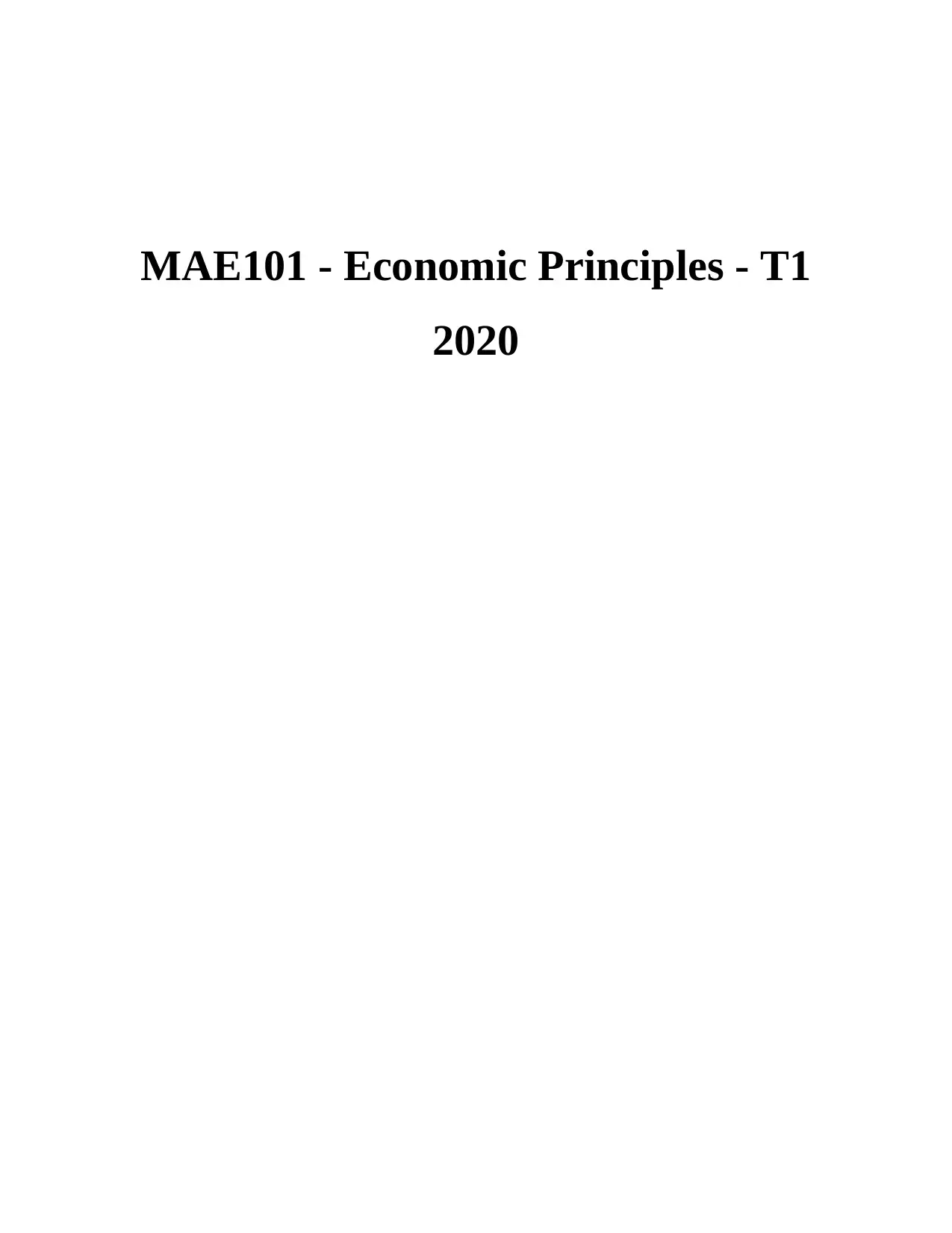
MAE101 - Economic Principles - T1
2020
2020
Paraphrase This Document
Need a fresh take? Get an instant paraphrase of this document with our AI Paraphraser
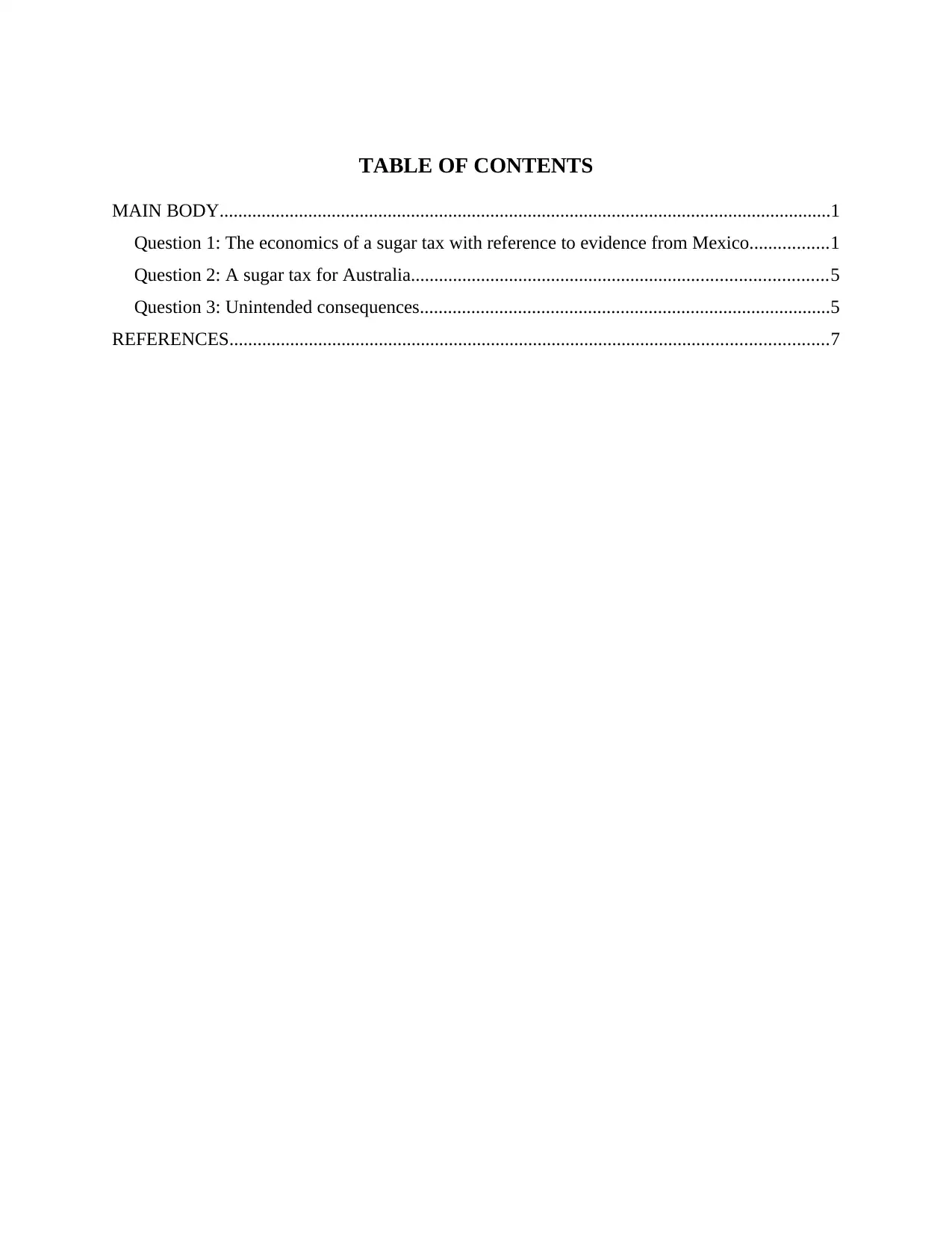
TABLE OF CONTENTS
MAIN BODY...................................................................................................................................1
Question 1: The economics of a sugar tax with reference to evidence from Mexico.................1
Question 2: A sugar tax for Australia.........................................................................................5
Question 3: Unintended consequences........................................................................................5
REFERENCES................................................................................................................................7
MAIN BODY...................................................................................................................................1
Question 1: The economics of a sugar tax with reference to evidence from Mexico.................1
Question 2: A sugar tax for Australia.........................................................................................5
Question 3: Unintended consequences........................................................................................5
REFERENCES................................................................................................................................7

MAIN BODY
Question 1: The economics of a sugar tax with reference to evidence from Mexico.
a
The formula for price elasticity of demand is percentage change in the quantity demanded upon
percentage change in price.
i) For the economy on average
Price elasticity of demand = Percentage change in the quantity demanded/ Percentage change in
price.
Price elasticity of demand = 7.6%/ 10%
Price elasticity of demand = 0.76
ii) For low income households
Price elasticity of demand = Percentage change in the quantity demanded/ Percentage change in
price.
Price elasticity of demand = 11.7%/ 10%
Price elasticity of demand = 1.17
b
If the price elasticity of demand is more than 1 then it is considered to be elastic which means
that the product is highly sensitive to the increase in price and vice versa. The economy on
average group is considered to be more responsive to the tax on Sugar Sweetened Beverage.
c
Non availability of the substitute goods will eventually result in increase in price of the
goods which has been available in the market.
The increase in the demand of the product also eventually leads to increase in the price of
the product.
Low degree of competition in the market is also referred to as one of the most significant
factor which results increase in the price of the product (Olmstead and et.al., 2015).
Monopoly of the product within the market is also one of the most relevant factor which
results in the increase in the price of the SSB product.
1
Question 1: The economics of a sugar tax with reference to evidence from Mexico.
a
The formula for price elasticity of demand is percentage change in the quantity demanded upon
percentage change in price.
i) For the economy on average
Price elasticity of demand = Percentage change in the quantity demanded/ Percentage change in
price.
Price elasticity of demand = 7.6%/ 10%
Price elasticity of demand = 0.76
ii) For low income households
Price elasticity of demand = Percentage change in the quantity demanded/ Percentage change in
price.
Price elasticity of demand = 11.7%/ 10%
Price elasticity of demand = 1.17
b
If the price elasticity of demand is more than 1 then it is considered to be elastic which means
that the product is highly sensitive to the increase in price and vice versa. The economy on
average group is considered to be more responsive to the tax on Sugar Sweetened Beverage.
c
Non availability of the substitute goods will eventually result in increase in price of the
goods which has been available in the market.
The increase in the demand of the product also eventually leads to increase in the price of
the product.
Low degree of competition in the market is also referred to as one of the most significant
factor which results increase in the price of the product (Olmstead and et.al., 2015).
Monopoly of the product within the market is also one of the most relevant factor which
results in the increase in the price of the SSB product.
1
⊘ This is a preview!⊘
Do you want full access?
Subscribe today to unlock all pages.

Trusted by 1+ million students worldwide

d
Cross Price Elastic of demand = % change in quantity demanded for Product A / % change
in price of product B
% change in quantity demanded for Sugar Sweetened Beverages is -7.6%. Whereas % change
in price of bottled water 64.5 %
-7.6/ 64.5 = -0.11
This means that Sugar Sweetened Beverage and Water bottle is complement of each other. This
means that increase in the price of one commodity leads to the fall of demand of other
commodity in the nation. Cross Price elastic generally looks at comprising the linkage between
price of one product lead to demand of another product. In above scenario also price of water
bottle has increased by 64.5% and decreased the demand of SSB by -7.6%
e
P hear stand for the prices of Sugar Sweetened Beverage. Q stands for the quantity of the product
produced. Blue color curve shows the demand of Sugar Sweetened Beverage and red Curve
shows the supply of Sugar Sweetened Beverage in the organization.
2
Cross Price Elastic of demand = % change in quantity demanded for Product A / % change
in price of product B
% change in quantity demanded for Sugar Sweetened Beverages is -7.6%. Whereas % change
in price of bottled water 64.5 %
-7.6/ 64.5 = -0.11
This means that Sugar Sweetened Beverage and Water bottle is complement of each other. This
means that increase in the price of one commodity leads to the fall of demand of other
commodity in the nation. Cross Price elastic generally looks at comprising the linkage between
price of one product lead to demand of another product. In above scenario also price of water
bottle has increased by 64.5% and decreased the demand of SSB by -7.6%
e
P hear stand for the prices of Sugar Sweetened Beverage. Q stands for the quantity of the product
produced. Blue color curve shows the demand of Sugar Sweetened Beverage and red Curve
shows the supply of Sugar Sweetened Beverage in the organization.
2
Paraphrase This Document
Need a fresh take? Get an instant paraphrase of this document with our AI Paraphraser
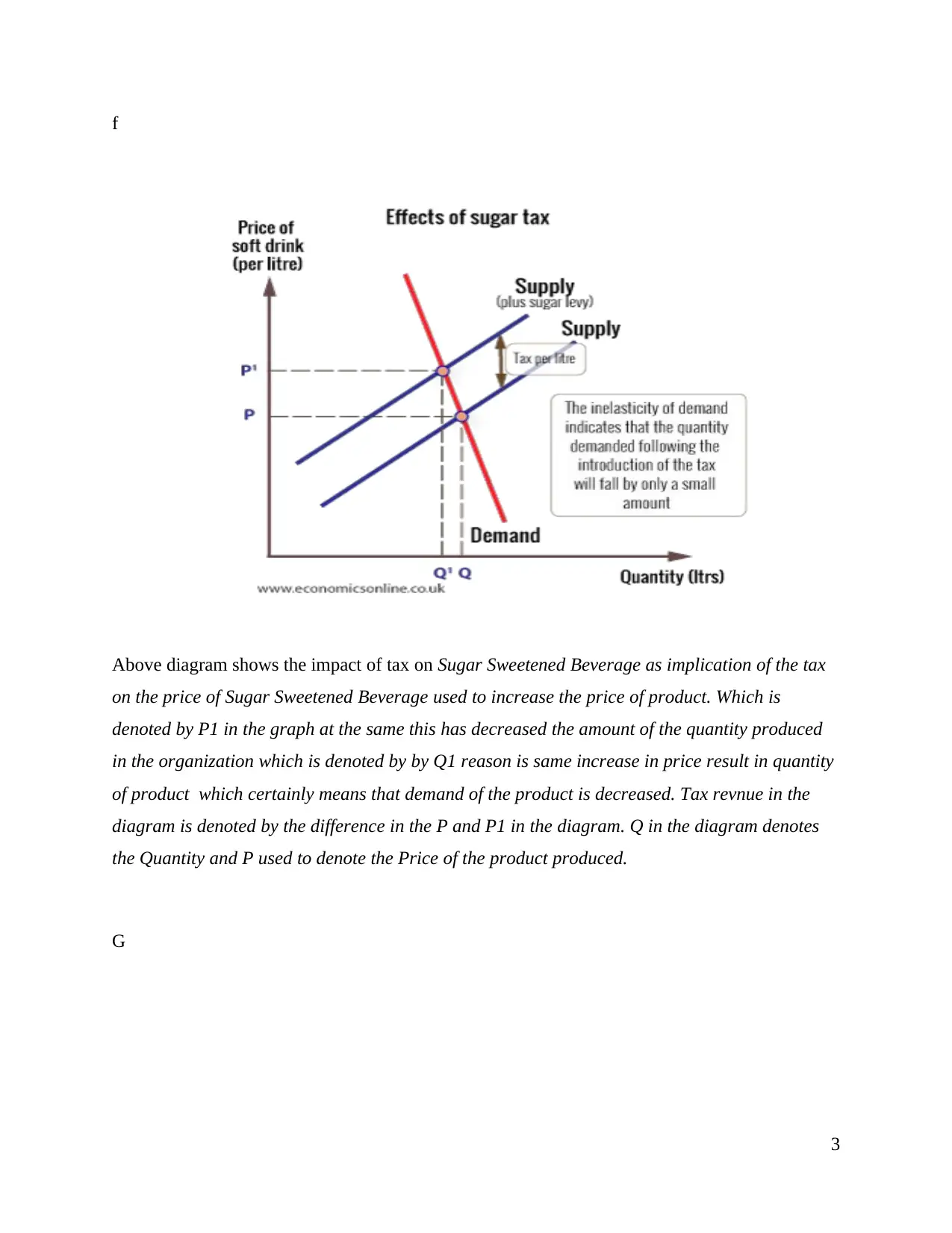
f
Above diagram shows the impact of tax on Sugar Sweetened Beverage as implication of the tax
on the price of Sugar Sweetened Beverage used to increase the price of product. Which is
denoted by P1 in the graph at the same this has decreased the amount of the quantity produced
in the organization which is denoted by by Q1 reason is same increase in price result in quantity
of product which certainly means that demand of the product is decreased. Tax revnue in the
diagram is denoted by the difference in the P and P1 in the diagram. Q in the diagram denotes
the Quantity and P used to denote the Price of the product produced.
G
3
Above diagram shows the impact of tax on Sugar Sweetened Beverage as implication of the tax
on the price of Sugar Sweetened Beverage used to increase the price of product. Which is
denoted by P1 in the graph at the same this has decreased the amount of the quantity produced
in the organization which is denoted by by Q1 reason is same increase in price result in quantity
of product which certainly means that demand of the product is decreased. Tax revnue in the
diagram is denoted by the difference in the P and P1 in the diagram. Q in the diagram denotes
the Quantity and P used to denote the Price of the product produced.
G
3
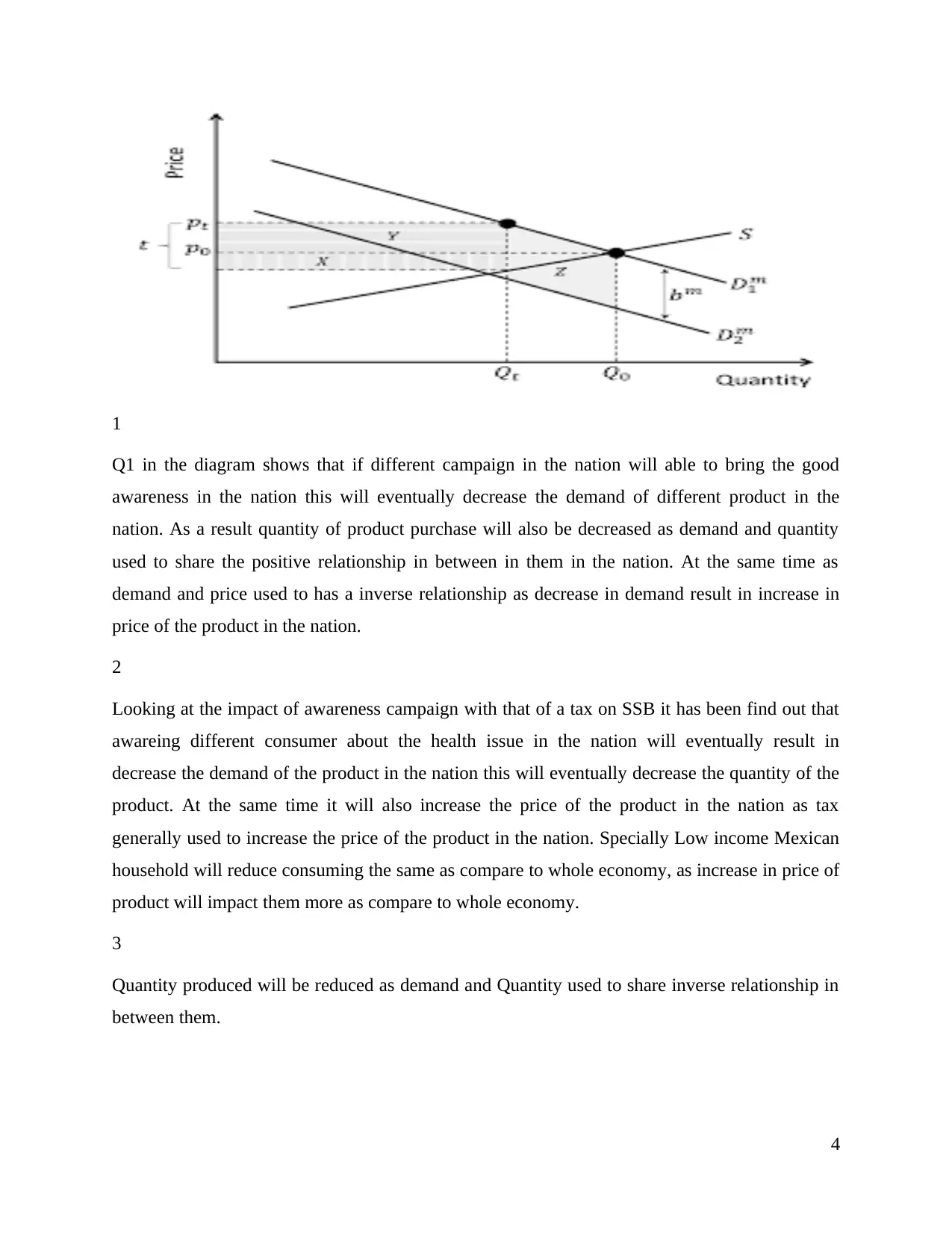
1
Q1 in the diagram shows that if different campaign in the nation will able to bring the good
awareness in the nation this will eventually decrease the demand of different product in the
nation. As a result quantity of product purchase will also be decreased as demand and quantity
used to share the positive relationship in between in them in the nation. At the same time as
demand and price used to has a inverse relationship as decrease in demand result in increase in
price of the product in the nation.
2
Looking at the impact of awareness campaign with that of a tax on SSB it has been find out that
awareing different consumer about the health issue in the nation will eventually result in
decrease the demand of the product in the nation this will eventually decrease the quantity of the
product. At the same time it will also increase the price of the product in the nation as tax
generally used to increase the price of the product in the nation. Specially Low income Mexican
household will reduce consuming the same as compare to whole economy, as increase in price of
product will impact them more as compare to whole economy.
3
Quantity produced will be reduced as demand and Quantity used to share inverse relationship in
between them.
4
Q1 in the diagram shows that if different campaign in the nation will able to bring the good
awareness in the nation this will eventually decrease the demand of different product in the
nation. As a result quantity of product purchase will also be decreased as demand and quantity
used to share the positive relationship in between in them in the nation. At the same time as
demand and price used to has a inverse relationship as decrease in demand result in increase in
price of the product in the nation.
2
Looking at the impact of awareness campaign with that of a tax on SSB it has been find out that
awareing different consumer about the health issue in the nation will eventually result in
decrease the demand of the product in the nation this will eventually decrease the quantity of the
product. At the same time it will also increase the price of the product in the nation as tax
generally used to increase the price of the product in the nation. Specially Low income Mexican
household will reduce consuming the same as compare to whole economy, as increase in price of
product will impact them more as compare to whole economy.
3
Quantity produced will be reduced as demand and Quantity used to share inverse relationship in
between them.
4
⊘ This is a preview!⊘
Do you want full access?
Subscribe today to unlock all pages.

Trusted by 1+ million students worldwide
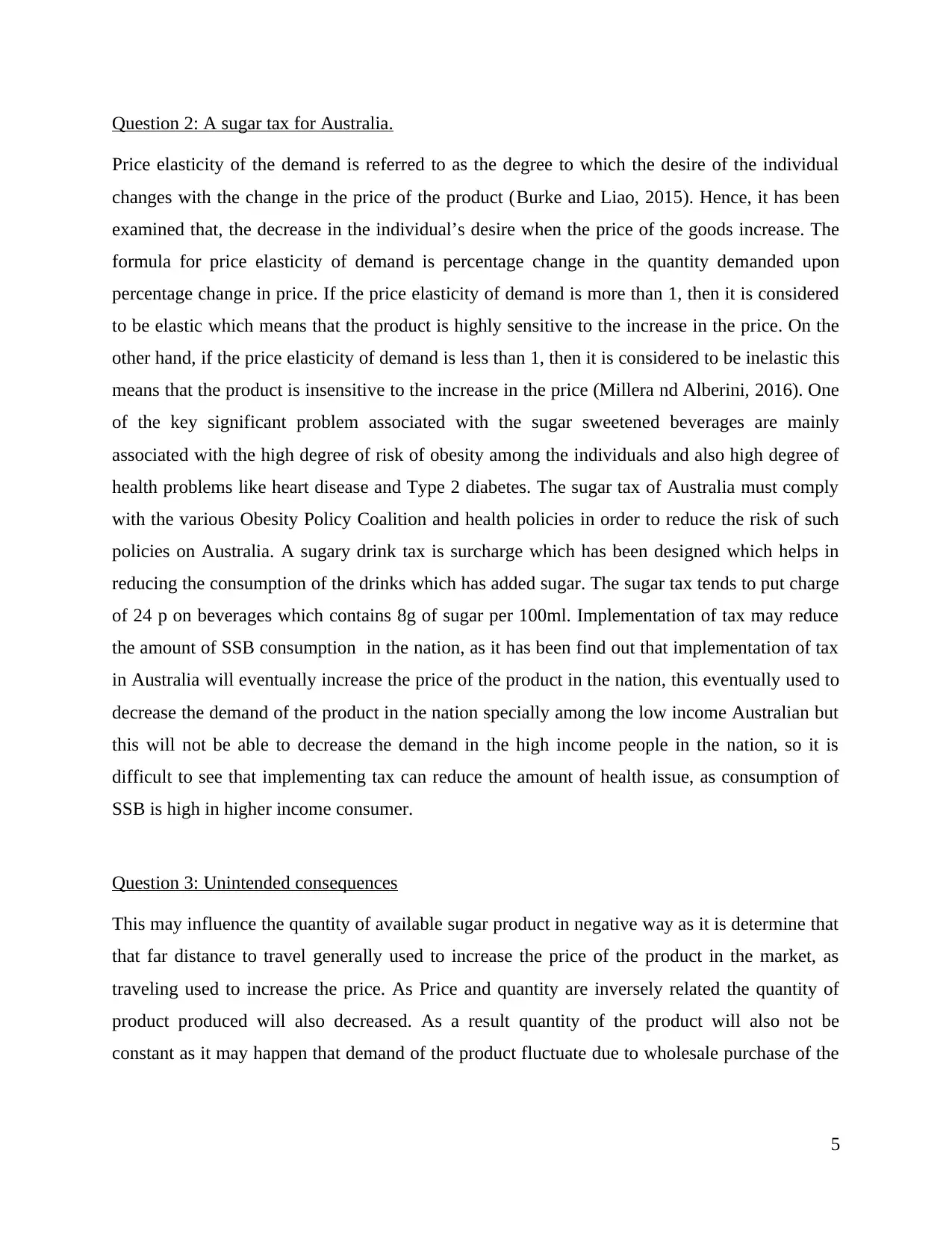
Question 2: A sugar tax for Australia.
Price elasticity of the demand is referred to as the degree to which the desire of the individual
changes with the change in the price of the product (Burke and Liao, 2015). Hence, it has been
examined that, the decrease in the individual’s desire when the price of the goods increase. The
formula for price elasticity of demand is percentage change in the quantity demanded upon
percentage change in price. If the price elasticity of demand is more than 1, then it is considered
to be elastic which means that the product is highly sensitive to the increase in the price. On the
other hand, if the price elasticity of demand is less than 1, then it is considered to be inelastic this
means that the product is insensitive to the increase in the price (Millera nd Alberini, 2016). One
of the key significant problem associated with the sugar sweetened beverages are mainly
associated with the high degree of risk of obesity among the individuals and also high degree of
health problems like heart disease and Type 2 diabetes. The sugar tax of Australia must comply
with the various Obesity Policy Coalition and health policies in order to reduce the risk of such
policies on Australia. A sugary drink tax is surcharge which has been designed which helps in
reducing the consumption of the drinks which has added sugar. The sugar tax tends to put charge
of 24 p on beverages which contains 8g of sugar per 100ml. Implementation of tax may reduce
the amount of SSB consumption in the nation, as it has been find out that implementation of tax
in Australia will eventually increase the price of the product in the nation, this eventually used to
decrease the demand of the product in the nation specially among the low income Australian but
this will not be able to decrease the demand in the high income people in the nation, so it is
difficult to see that implementing tax can reduce the amount of health issue, as consumption of
SSB is high in higher income consumer.
Question 3: Unintended consequences
This may influence the quantity of available sugar product in negative way as it is determine that
that far distance to travel generally used to increase the price of the product in the market, as
traveling used to increase the price. As Price and quantity are inversely related the quantity of
product produced will also decreased. As a result quantity of the product will also not be
constant as it may happen that demand of the product fluctuate due to wholesale purchase of the
5
Price elasticity of the demand is referred to as the degree to which the desire of the individual
changes with the change in the price of the product (Burke and Liao, 2015). Hence, it has been
examined that, the decrease in the individual’s desire when the price of the goods increase. The
formula for price elasticity of demand is percentage change in the quantity demanded upon
percentage change in price. If the price elasticity of demand is more than 1, then it is considered
to be elastic which means that the product is highly sensitive to the increase in the price. On the
other hand, if the price elasticity of demand is less than 1, then it is considered to be inelastic this
means that the product is insensitive to the increase in the price (Millera nd Alberini, 2016). One
of the key significant problem associated with the sugar sweetened beverages are mainly
associated with the high degree of risk of obesity among the individuals and also high degree of
health problems like heart disease and Type 2 diabetes. The sugar tax of Australia must comply
with the various Obesity Policy Coalition and health policies in order to reduce the risk of such
policies on Australia. A sugary drink tax is surcharge which has been designed which helps in
reducing the consumption of the drinks which has added sugar. The sugar tax tends to put charge
of 24 p on beverages which contains 8g of sugar per 100ml. Implementation of tax may reduce
the amount of SSB consumption in the nation, as it has been find out that implementation of tax
in Australia will eventually increase the price of the product in the nation, this eventually used to
decrease the demand of the product in the nation specially among the low income Australian but
this will not be able to decrease the demand in the high income people in the nation, so it is
difficult to see that implementing tax can reduce the amount of health issue, as consumption of
SSB is high in higher income consumer.
Question 3: Unintended consequences
This may influence the quantity of available sugar product in negative way as it is determine that
that far distance to travel generally used to increase the price of the product in the market, as
traveling used to increase the price. As Price and quantity are inversely related the quantity of
product produced will also decreased. As a result quantity of the product will also not be
constant as it may happen that demand of the product fluctuate due to wholesale purchase of the
5
Paraphrase This Document
Need a fresh take? Get an instant paraphrase of this document with our AI Paraphraser
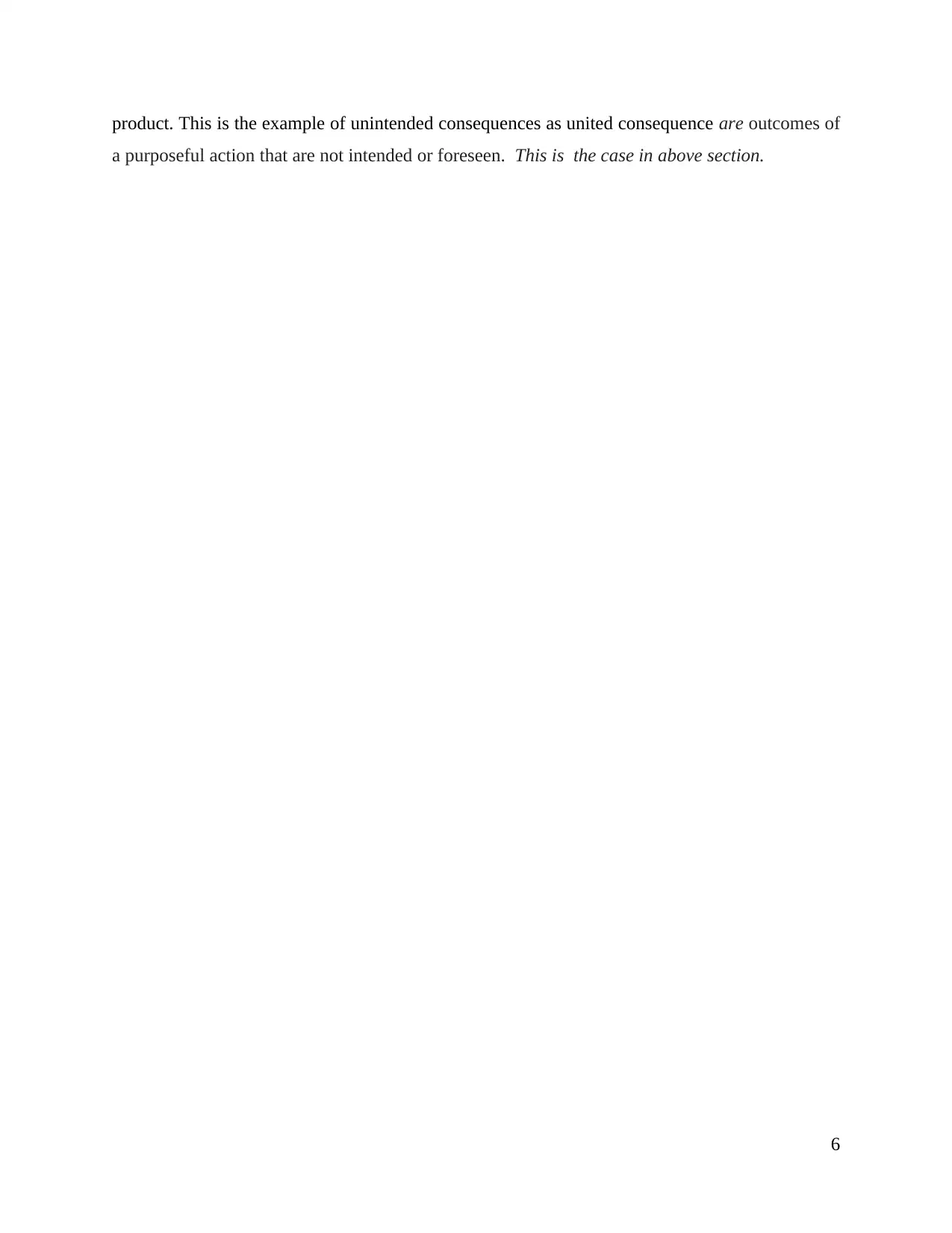
product. This is the example of unintended consequences as united consequence are outcomes of
a purposeful action that are not intended or foreseen. This is the case in above section.
6
a purposeful action that are not intended or foreseen. This is the case in above section.
6
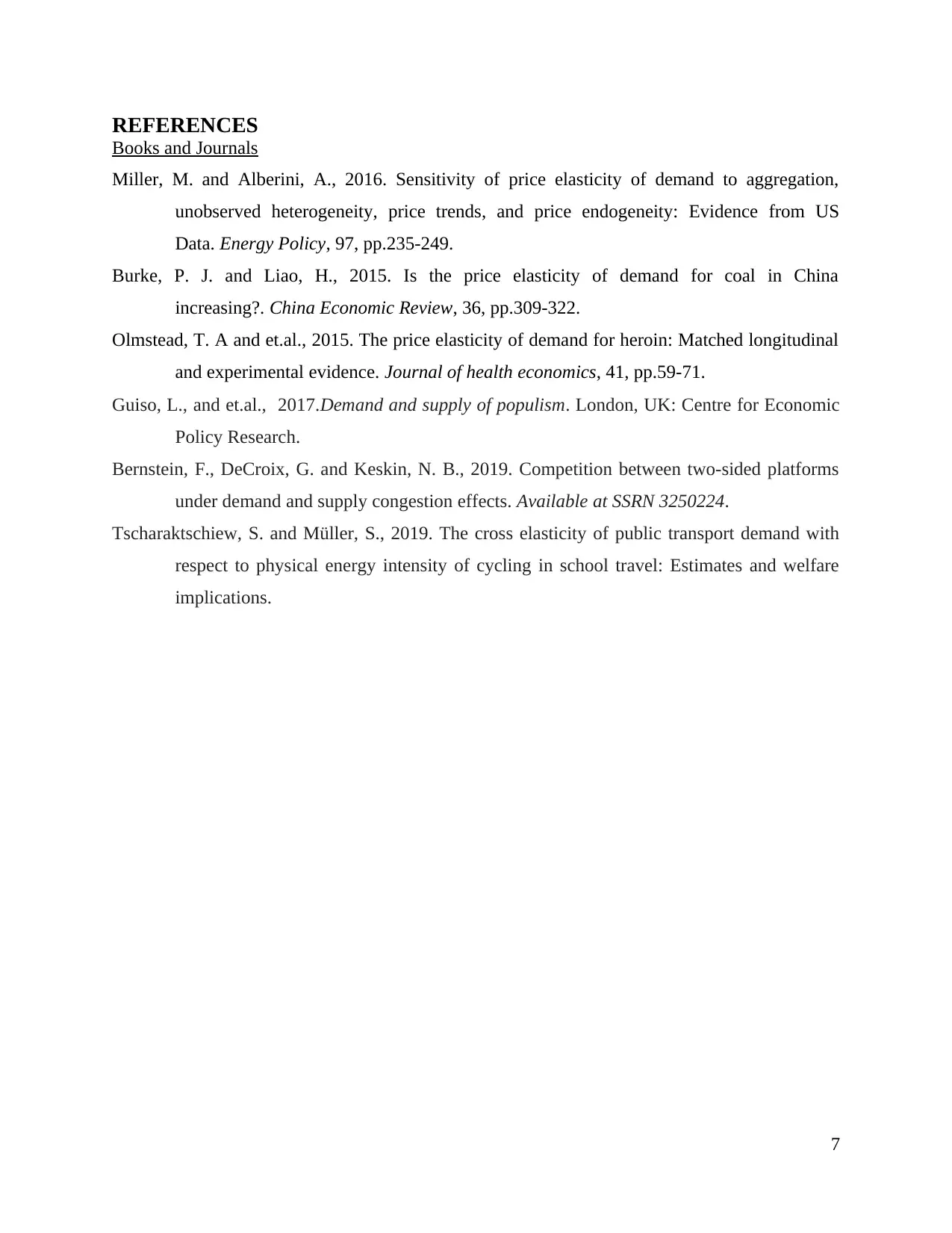
REFERENCES
Books and Journals
Miller, M. and Alberini, A., 2016. Sensitivity of price elasticity of demand to aggregation,
unobserved heterogeneity, price trends, and price endogeneity: Evidence from US
Data. Energy Policy, 97, pp.235-249.
Burke, P. J. and Liao, H., 2015. Is the price elasticity of demand for coal in China
increasing?. China Economic Review, 36, pp.309-322.
Olmstead, T. A and et.al., 2015. The price elasticity of demand for heroin: Matched longitudinal
and experimental evidence. Journal of health economics, 41, pp.59-71.
Guiso, L., and et.al., 2017.Demand and supply of populism. London, UK: Centre for Economic
Policy Research.
Bernstein, F., DeCroix, G. and Keskin, N. B., 2019. Competition between two-sided platforms
under demand and supply congestion effects. Available at SSRN 3250224.
Tscharaktschiew, S. and Müller, S., 2019. The cross elasticity of public transport demand with
respect to physical energy intensity of cycling in school travel: Estimates and welfare
implications.
7
Books and Journals
Miller, M. and Alberini, A., 2016. Sensitivity of price elasticity of demand to aggregation,
unobserved heterogeneity, price trends, and price endogeneity: Evidence from US
Data. Energy Policy, 97, pp.235-249.
Burke, P. J. and Liao, H., 2015. Is the price elasticity of demand for coal in China
increasing?. China Economic Review, 36, pp.309-322.
Olmstead, T. A and et.al., 2015. The price elasticity of demand for heroin: Matched longitudinal
and experimental evidence. Journal of health economics, 41, pp.59-71.
Guiso, L., and et.al., 2017.Demand and supply of populism. London, UK: Centre for Economic
Policy Research.
Bernstein, F., DeCroix, G. and Keskin, N. B., 2019. Competition between two-sided platforms
under demand and supply congestion effects. Available at SSRN 3250224.
Tscharaktschiew, S. and Müller, S., 2019. The cross elasticity of public transport demand with
respect to physical energy intensity of cycling in school travel: Estimates and welfare
implications.
7
⊘ This is a preview!⊘
Do you want full access?
Subscribe today to unlock all pages.

Trusted by 1+ million students worldwide
1 out of 9